|
Location:
Peloponnese, Greece. |
Grid Reference:
37� 39' N,
22� 52' E. |
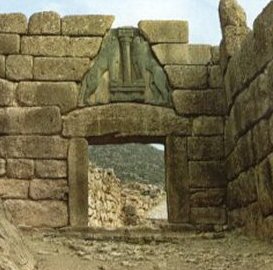
 Mycenae:
(Capital of the Mycenaean Empire).
Mycenae:
(Capital of the Mycenaean Empire).
The period of Greek history from about 1600 BC to
about 1100 BC is called Mycenaean in reference to Mycenae.
In the second millennium BC Mycenae was one of the major centres of
Greek civilization and a military stronghold which would have dominated much of
southern Greece. The Mycenaean civilization filled the vacuum of the
Minoans following the Santorini disaster in the 16th cent BC. There are
several indications that they originated from the middle east (Phrygia).
The fact
that both Greek and Roman travelers used to measure 1 degree of latitude
at 600 Greek Stadia or 75 Roman miles, a measure which is only correct at
the latitude of Mycenae, adds to the suggestion that their system of
calculation traces back to their Mycenaean ancestors.
(Click here for
map of Citadel)
Article: May. 2013: 'Mysterious Mayans
Were European According to DNA'
The Minoans, the builders of Europe's first
advanced civilization, really were European, new research
suggests. The conclusion, published today (May 14) in the
journal Nature Communications, was drawn by comparing DNA from
4,000-year-old Minoan skeletons with genetic material from
people living throughout Europe and Africa in the past and
today.
(Link
to Full Article)
Article: Oct. 2009: 'The Worlds Oldest
Submerged Town' -
Archaeologists surveying the world�s oldest submerged town have found
ceramics dating back to the Final Neolithic. Their discovery suggests
that Pavlopetri, off the southern Laconia coast of Greece, was
occupied some 5,000 years ago � at least 1,200 years earlier than
originally thought.
(Link to Full Article)
|
Mycenaea: The Mycenaean's |
Greek legend always maintains that the Pelopidae of Mycenae came from
Phyrgia, which is corroborated by archaeology. The
objects found in excavations, and the sculptured ornament on the
doorways of the "Treasuries" and over the Lion Gate, all point to
foreign influence and particularly to Asia Minor. The same type of the
two lions and the column has been recently found over the entrance to a
colossal sepulchre in the rocks near the south-western corner of the Sangarius valley in Phyrgia. Legend and remains alike show that a rich
and powerful dynasty of foreign origin ruled at Mycenae; the only early
remains in the Greek world that equal them in interest are the ruins of
ancient Troy. It is precisely these two cities which are described in
the Homeric poems as the two great cities of the Greek world.
The city is surrounded by two walls, built of
cyclopean blocks on the lower and older courses.
The Lion-Gate.
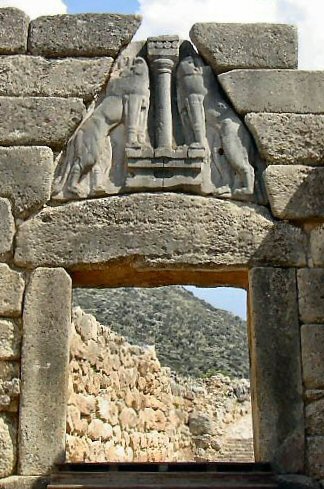 The primary entrance to the city is flanked on either side by the city wall. Over the entrance is placed a triangular slab of stone
into which
the now famous carved lions face one another,
separated by an upright column. The primary entrance to the city is flanked on either side by the city wall. Over the entrance is placed a triangular slab of stone
into which
the now famous carved lions face one another,
separated by an upright column.
(Note the similarity in design to the entrance at
the 'Treasury of Atreus')
The art of this relief shows no
resemblance to archaic Greek art; in is foreign in character, the work
of immigrant race, which brought with it a well-developed civilization.
The same art can be seen in
Mesopotamian art of the same period, as seen in this Phrygian Lion Gate,
below.
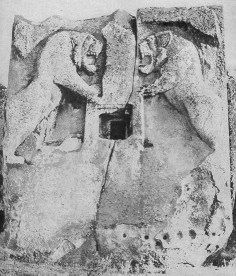
The classic symbol of two flanking lions has middle eastern roots
tracing back to Sumeria, where the hero/king Gilgamesh was always portrayed
in such a way. Flanking lions are also found at the gates of Important
Middle eastern cities such as
Boghazkoy and Alaja
H�y�k .
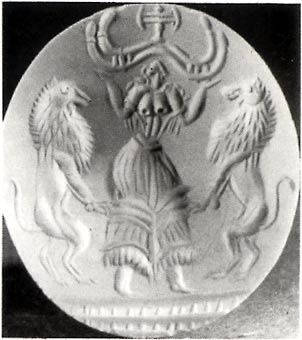
Mycenaean snake-goddess, following the tradition of the Minoan (Cretan)
snake-goddess.
|
'Cyclopean' Walls.
The renowned cyclopean walls of Tiryns and Mycenae are attributed to the
Mycenaeans, also called the Achaeans or Pelasgians, and are generally
assigned to the 14th and 13th centuries BCE. Greek tradition asserts
that they were built by the Cyclopes, mythical one-eyed giants.
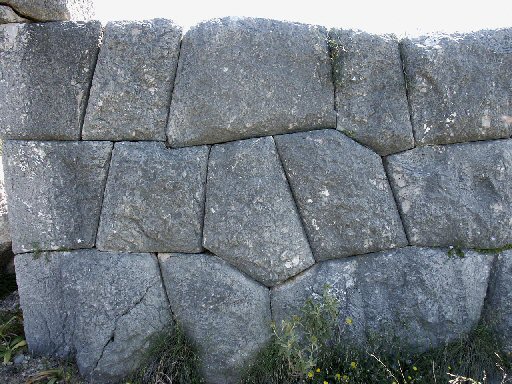
A superb example at Paleo Kastro-Agios Adrianos.
In the 19th and early 20th centuries some scholars ascribed many of
these walls and buildings to the ancient Pelasgians, but their
history was so hard to unravel most modern works make almost no
reference to them. At most, modern textbooks consider them to be the
earliest inhabitants of Greece before the invasion of the
Mycenaeans. In fact it appears that the term Mycenaeans was invented to
replace these hard to trace Pelasgians - as noted by Professor William
Ridgeway in The Early Age of Greece.
(Other examples of 'cyclopean' masonry) |
Tholoi: Omphalos-shaped chambers.
Nine significant Tholoi have been discovered in ancient Mycenae, with
the so-called 'Treasury of Atreus' being the most impressive.
Tholoi are characterised by their internal domed chamber, normally
referred to as 'Beehive-shaped'.
Numerous other 'Tholoi' are recorded
around the Mediterranean and the Middle-east, where they were commonly
used for burial, but in some cases they were used for other purposes
such as homes (Cyprus), ritual (Syria), and even fortification (Spain,
Sardinia). The ultimate origin of this architectural technique can be
seen in both the Neolithic cultures of Tell Halaf (Syria and Turkey),
with echoes in the Neolithic Western-Atlantic passage-mounds.
The 'Treasury' of Atreus.
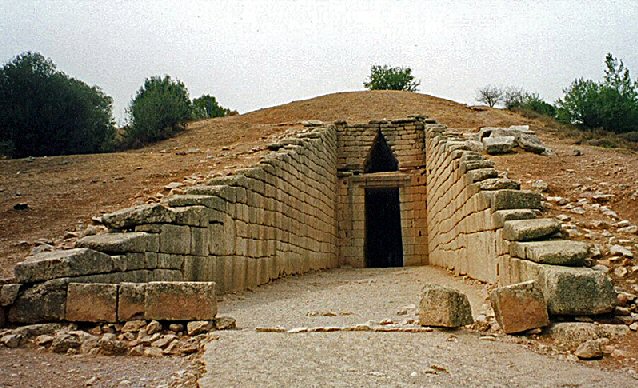
No cement was used with the masonry. The blocks were cut to fit together
perfectly, with the largest (the lintel), weighing around 120 tons.
(Link to the Top-50 Megaliths)
According to Wilhelm Dorpfeld it is true that:
'...all these tombs, great as well as small, were once closed;
the only question is when it was done. As both the great tholoi
at Mycenae were provided with rich fa�ades and had their wooden
doors overlaid with metals, it appears to me more probable that they
were not forthwith blocked up. . . . it is the fact that the walls,
built to block up the two great tholoi, are not of the same
material as the tombs themselves'. -- Dorpfeld's Introduction to
The Mycenaean Age -- A Study of the Monuments and Culture of
Prehomeric Greece by Chrestos Tsountas and J. Irving Manatt
(1897), pp. xxvi-xxvii
This means that the skeletons found in some tholoi could date from
a later period, and proof that skeletons found inside the tholoi do
not belong to the period of the original builders is found in the
observation that:
As a rule, the body was simply laid on the floor of the
tholos or the chamber, not covered with earth nor placed in a
coffin of wood or stone, of which not a trace has yet been found. .
. . For repeated observations prove that, as often as the area of
the chamber or the tholos became crowded with corpses, the earlier
remains were gathered in heaps in the corners, or buried in shallow
trenches, so as to make room for the new interments. -- Ibid., pp.
136-7
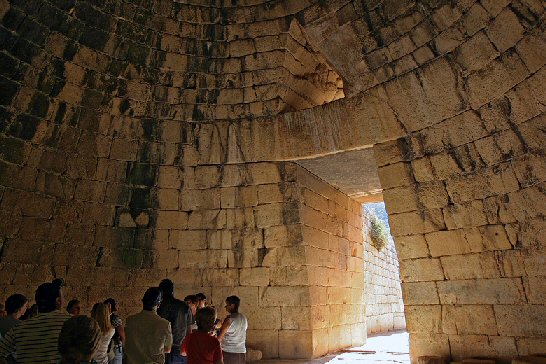
The inside space creates a
negative-space 'Omphalos'.
Pennick (28), notes that the Roman author Varro compared the
omphalos shape with a �treasury�, the name commonly applied to
dome-shaped graves (such as the �Treasury of Atreus� at Mycenae, so
described by Pausanias). The suggestion that the Treasury of Atreus may
be an omphalos of �negative space�, is of interest as we are told that
the site was �Treasury� was built on the site of the old oracle of the
earth goddess herself, with legends stating that Python, the serpent
spirit of the earth, lays buried there having been killed by Apollo the
sun god.
(More about Omphalos)
The Tragedy of Atreis: A
Mycenaean Myth..
Following the death of the last
member of the Perseid dynasty, the Mycenaean's went to the oracle at
Delphi, who told them to summon Atreus and Theyestes, the two sons of
Pelops, in order to choose on of them as a king. Atreus won their favour
and ascended the throne of Mycenae, however, he quarrelled with his
brother, who plotted against him with the help of Atreus' wife, Aerope,
who was also his lover. To avenge himself, Atreus invited him to dinner
where he offered Thyestes the flesh of his sons, thus bringing upon
himself a curse blighting his destiny and that of all the offspring.
|
A Mycenaean Connection with
Stonehenge?
For a while it was debated as to
whether or not there may have been a connection between the builders of
Stonehenge and the Mycenaean's. Current dating suggests that while
the Mycenaean civilisation existed from around 1,600 BC - 1,100 BC, the
Stonehenge sarsen's were erected around 600 years earlier and the debate has
now been been
laid to rest.
The curved Mycenaean
lintels have been compared to the Stonehenge lintels, which have
no precedent in British prehistoric architecture.
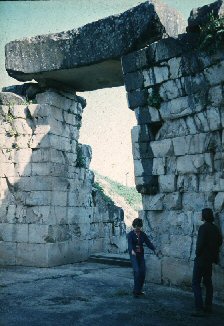
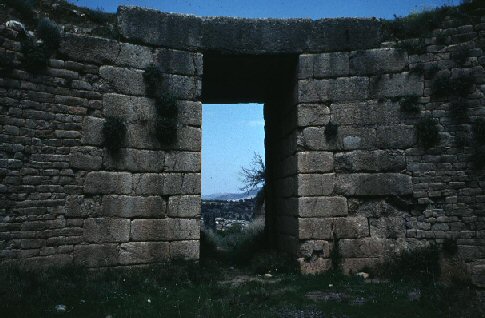
The Mycenaean tombs or Tholos
all had curved lintels over the entrances.
In 1953, a
carving of what appears to be a Mycenaean dagger (below, left),
was found carved onto a stone at Stonehenge.
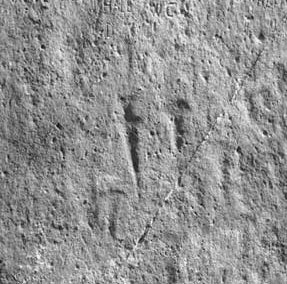
This discovery raised the suggestion
that the stones were raised by Mycenaean architects as the nearest
artefacts with any similarity to this dagger are those found in Mycenae.
However, the date for the
erection of the bluestones at Stonehenge has since been revised, as
pointed out in the book Hengeworld by Mike Pitts, (0-09-927875-8), on
page 341 he states that the "large sarsen structures" of Stonehenge have
been dated with 95% confidence to between 2461 & 2205 bce., at the
inside more than 600 years earlier .. It also seems to place these
carvings well after the bluestone circle & oval, said to date from
between 2267 & 1983 bce. (page 342).
At best then, the dagger might
represent a Mycenaean visit to Stonehenge, but no more.
(More about Stonehenge) |
Mycenaean daggers.

'It would take a very skilful man
to-day, a man who was both goldsmith and artist, to make such daggers as men
found at Mycenae. First the blade was made. Then the artist took a separate
sheet of bronze for his design. This sheet he enamelled, and on it he inlaid
his design. On one of these daggers we see five hunters fighting three
lions. Two of the lions are running away. One lion is pouncing upon a
hunter, but his friends are coming to help him. If you could turn this
dagger over, you would see a lion chasing five gazelles. The artist used
pure gold for the bodies of the hunters and the lions; he used electron, an
alloy of gold and silver, for the hunters' shields and their trousers; and
he made the men's hair, the lions' manes, and the rims of the shields, of
some black substance. When the picture was finished on the plate, he set the
plate into the blade, and riveted on the handle. On the smaller dagger we
see three lions running'. (Jaennie Hall)
|

 The primary entrance to the city is flanked on either side by the city wall. Over the entrance is placed a triangular slab of stone
into which
the now famous carved lions face one another,
separated by an upright column.
The primary entrance to the city is flanked on either side by the city wall. Over the entrance is placed a triangular slab of stone
into which
the now famous carved lions face one another,
separated by an upright column. 







